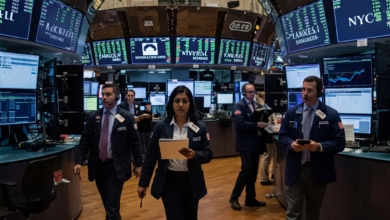How Interest Rates Affect Stock Market Prices
Understand how interest rates impact the price of your investments

Of all the forces that move the stock market, none are as powerful or as misunderstood as interest rates. While dramatic headlines about corporate earnings or new technology grab our attention, the slow, methodical decisions made by the Federal Reserve on interest rates act like a form of financial gravity, quietly influencing the value of everything in your investment portfolio.
But how can a seemingly small change—a quarter of a percentage point—send ripples, or even tidal waves, through the entire stock market? The connection isn’t always obvious, but it is profound.
This guide will demystify that relationship. We will break down, in simple terms, the multiple ways the “cost of money” impacts company profits, investor psychology, and the fundamental value of your stocks. Understanding this concept is not just for economists; it’s essential knowledge for anyone looking to build and protect their wealth over the long term.
Understanding the Federal Reserve and the ‘Cost of Money’

Before we can connect the dots to the stock market, we need to understand the source. In the United States, the primary driver of interest rates is the Federal Reserve, often simply called “the Fed.” The Fed’s main tool is the federal funds rate.
This isn’t an interest rate you pay directly. Instead, it’s the target rate at which commercial banks borrow and lend their excess reserves to each other overnight. Think of it as the foundational “cost of money” for the entire financial system.
When the Fed raises the federal funds rate, it becomes more expensive for banks to borrow money. Banks pass this higher cost on to their customers, leading to higher rates on everything from mortgages and car loans to credit cards and, crucially, business loans.
When the Fed lowers the rate, the opposite happens. Borrowing becomes cheaper, encouraging spending and investment throughout the economy. The Fed adjusts this rate as part of its dual mandate: to keep prices stable (control inflation) and to foster maximum employment.
The Direct Hit: How Higher Rates Squeeze Corporate Profits
The most direct way interest rates affect stock prices is by impacting the bottom line of the companies themselves. Stocks, after all, represent ownership in a business, and a stock’s value is largely derived from its current and future profitability.
Here’s how higher interest rates act as a headwind for businesses:
- Increased Borrowing Costs: Most companies carry debt. They borrow money to fund expansion, invest in research and development (R&D), manage day-to-day operations, or buy back their own stock. When interest rates rise, the cost of servicing existing variable-rate debt goes up, and any new loans become more expensive. This increased interest expense directly reduces a company’s net income, or profit. Lower profits generally lead to lower stock valuations.
- Reduced Consumer Spending: The impact isn’t just on corporations; it hits their customers, too. When rates on mortgages, auto loans, and credit card balances increase, households have less disposable income. Monthly payments go up, leaving less money for discretionary purchases like new electronics, vacations, or dining out. This reduction in consumer demand leads to lower revenues for a wide range of companies, again hurting their profitability and stock prices.
The Great Investment Rivalry: Stocks vs. Bonds
Investing is all about choices and opportunity cost. When you put a dollar into the stock market, you’re choosing not to put it somewhere else. This is where the competition between stocks and bonds comes into play, and interest rates are the referee.
- When Rates Are Low (The TINA Environment): When interest rates on safe investments like U.S. Treasury bonds or high-quality corporate bonds are near zero, investors seeking a decent return have few options. This creates a “There Is No Alternative” (TINA) environment. Investors are almost forced to take on the higher risk of the stock market to generate meaningful returns, which pushes stock prices up.
- When Rates Are High (The TARA Environment): When the Fed raises rates, the dynamic flips. Suddenly, those “boring” government bonds might offer a guaranteed return of 4%, 5%, or even more. This creates a “There Are Reasonable Alternatives” (TARA) situation. An investor might ask, “Why should I risk my money in the volatile stock market for a potential 8% return when I can get a risk-free 5%?”
As rates rise, a significant amount of money can flow out of the stock market and into the bond market. This selling pressure on stocks naturally pushes their prices down. The higher the “risk-free” rate goes, the less attractive stocks become in comparison.
How Future Profits Are Valued Today: The Discounting Effect

This is a slightly more advanced concept, but it’s critical for understanding stock valuation. The theoretical value of a stock is the sum of all its expected future earnings, “discounted” back to their value in today’s dollars.
Think of it this way: a promise of $100 a year from now is worth less than $100 in your hand today. Why? Because you could take that money today and invest it risk-free to earn interest. The interest rate you could earn is the “discount rate.”
When interest rates are very low (say, 1%), that future $100 is worth about $99 today. But when interest rates are high (say, 5%), that future $100 is only worth about $95 today.
The same logic applies to stocks. Analysts use sophisticated models called Discounted Cash Flow (DCF) analyses to value companies. A key input in these models is the discount rate, which is heavily influenced by the prevailing interest rates.
When the Fed raises rates, the discount rate used to value future corporate earnings goes up. As a result, the present value of all those future earnings goes down. This means that, even if a company’s business forecast hasn’t changed at all, its stock is mathematically worth less today simply because interest rates are higher.
Which Market Sectors Are Most Sensitive to Interest Rate Changes?
Not all stocks react to interest rate changes in the same way. Some sectors are far more sensitive than others.
- Sectors That Get Hurt Most by RISING Rates:
- Growth Stocks (especially Tech): These companies’ valuations are heavily based on the promise of large profits far in the future. As we saw with the discounting effect, those distant earnings are worth much less in a high-rate environment, making these stocks particularly vulnerable.
- Real Estate (REITs): The real estate sector is highly dependent on debt. Higher rates make mortgages more expensive, cooling the housing market. For commercial real estate, higher borrowing costs make it harder to finance new projects and can squeeze profits.
- Utilities: Utility stocks are often treated as “bond proxies” because they are stable businesses that pay high, consistent dividends. When bond yields rise, they offer a safe alternative to utility dividends, making utility stocks less attractive by comparison.
- Sectors That Can Benefit (or are less hurt) by RISING Rates:
- Financials (Banks): Banks can actually benefit from rising rates, at least initially. Their business model is to profit from the “net interest margin”—the spread between the interest they pay on deposits and the interest they earn on loans. As rates rise, this spread often widens, boosting their profitability.
- Consumer Staples: These are companies that sell essential goods like food, beverages, and household products (think Procter & Gamble or Coca-Cola). Demand for these products tends to be stable regardless of the economic environment, making them less sensitive to the consumer spending slowdown caused by higher rates.
What Happens When Interest Rates Fall? The Other Side of the Coin

Just as rising rates act as gravity on stocks, falling rates can act as rocket fuel. The entire process works in reverse:
- Borrowing becomes cheaper for companies, stimulating investment and boosting profits.
- Consumer loan payments decrease, freeing up disposable income and encouraging spending.
- Bond yields become less attractive, pushing investors toward the stock market in search of better returns (the TINA effect returns).
- The discount rate on future earnings decreases, making stocks fundamentally more valuable.
This is why the market often celebrates when the Fed signals it is done hiking rates or is considering rate cuts. It’s seen as a green light for economic activity and higher asset prices.
How Should You Position Your Portfolio? Actionable Investor Takeaways
Understanding this relationship shouldn’t cause you to panic or make drastic changes every time a Fed official speaks. Instead, use this knowledge to become a smarter, more resilient investor.
- Focus on the Long Term: Don’t try to time the market based on rate predictions. The market’s short-term reaction is unpredictable. A long-term focus on owning quality businesses is a more reliable path to success.
- Embrace Diversification: A well-diversified portfolio, spread across different sectors and asset classes (like bonds), is your best defense. Some parts of your portfolio may struggle in a rising-rate environment, while others may perform well.
- Prioritize Quality Balance Sheets: In a high-rate world, companies with a lot of debt are at a disadvantage. Look for businesses with strong cash flow and low levels of debt, as they are better insulated from rising borrowing costs.
- Don’t Fight the Fed: This old market adage holds true. When the Fed is aggressively raising rates to fight inflation, it’s generally a time for caution. When the Fed is lowering rates to stimulate the economy, it’s typically a tailwind for stocks.
By understanding the powerful, gravitational pull of interest rates, you can better contextualize market movements and make more informed, less emotional decisions for your financial future.




